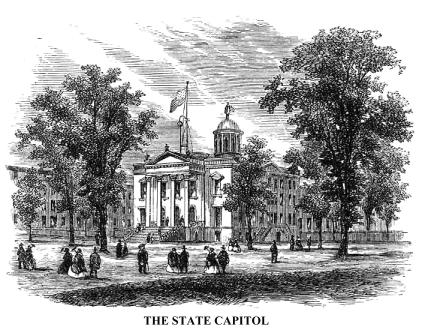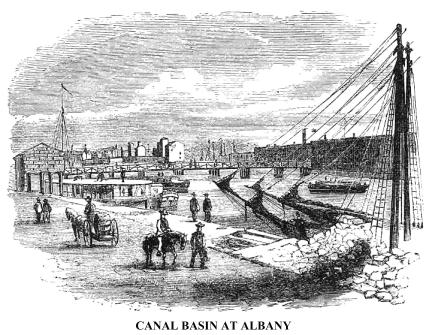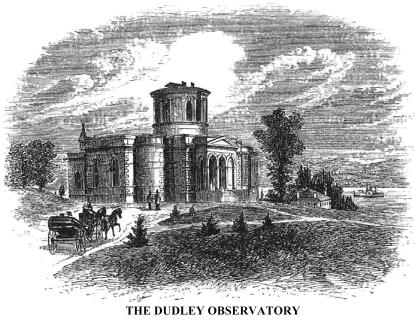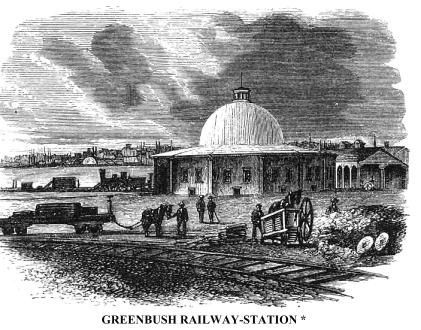CHAPTER VII, Part Two
 Albany
contained only about six thousand inhabitants when it was made the State capital,
and its progress in business and population was very slow until the successful
establishment of steam-boat navigation on the Hudson, and the completion of
that stupendous work of internal improvement, the Eric Canal, by which the
greatest of the inland seas of the United States (Lake Erie, Huron, Michigan,
and Superior) were connected by navigable waters with the Atlantic Ocean,
through the Hudson River. The idea of such connection had occupied the minds
of sagacious men for many years, foremost among whom were Elkanah Watson,
General Philip Schuyler, Christopher Colles, and Gouverneur Morris; and thirty
years before the great work was commenced, Joel Barlow, one of the early American
poets, wrote in his Vision of Columbus--
Albany
contained only about six thousand inhabitants when it was made the State capital,
and its progress in business and population was very slow until the successful
establishment of steam-boat navigation on the Hudson, and the completion of
that stupendous work of internal improvement, the Eric Canal, by which the
greatest of the inland seas of the United States (Lake Erie, Huron, Michigan,
and Superior) were connected by navigable waters with the Atlantic Ocean,
through the Hudson River. The idea of such connection had occupied the minds
of sagacious men for many years, foremost among whom were Elkanah Watson,
General Philip Schuyler, Christopher Colles, and Gouverneur Morris; and thirty
years before the great work was commenced, Joel Barlow, one of the early American
poets, wrote in his Vision of Columbus--
"He saw as widely spreads the unchannelled plain,
Where inland realms for ages bloomed in vain,
Canals, long winding, ope a watery flight,
And distant streams, and seas, and lakes unite.
"From fair Albania tow'rd the failing sun,
Back through the midland lengthening channels run;
Meet the far lakes, their beauteous towns that lave,
And Hudson joined to broad Ohio's wave."
The Erie Canal enters the Hudson at Albany. Its western terminus
is the city of Buffalo, at the east end of Lake Erie. The length of the canal is 360 miles, and its original width was
forty feet, with depth sufficient to bear boats of eighty tons burden. It
was completed in the year 1825, at a cost to the State of nearly eight millions
of dollars. The business demands upon it warranting an enlargement to seventy
feet in width, work with that result in view has been in progress for several
years. It flows through the entire length of the beautiful Mohawk valley,
crosses the Mohawk River several times, and enters Albany at the north end
of the city.
Lake Erie. The length of the canal is 360 miles, and its original width was
forty feet, with depth sufficient to bear boats of eighty tons burden. It
was completed in the year 1825, at a cost to the State of nearly eight millions
of dollars. The business demands upon it warranting an enlargement to seventy
feet in width, work with that result in view has been in progress for several
years. It flows through the entire length of the beautiful Mohawk valley,
crosses the Mohawk River several times, and enters Albany at the north end
of the city.
Near where the last aqueduct of the canal crosses the Mohawk River, the rapids above Cohoes Falls commence. The Indians had a touching legend connected with these rapids, that exhibits, in brief sentences, a vivid picture of the workings of the savage mind.
Occuna, a young Seneca warrior, and his affianced were carelessly paddling along the river in a canoe, at the head of the rapids, when they suddenly perceived themselves drawn irresistibly by the current to the middle of, and down, the stream towards the cataract. When they found deliverance to be impossible, the lovers prepared to meet the great Master of Life with composure, and began the melancholy death-song, in responsive sentences. Occuna began: "Daughter of a mighty warrior! the Great Manitore [the Supreme God] calls me hence; he bids me hasten into his presence; I hear his voice in the stream; I perceive his Spirit in the moving of the waters. The light of his eyes danceth upon the swift rapids."
The maiden replied: "Art thou not thyself a mighty warrior, O Occuna? Hath not thy hatchet been often bathed in the red blood of thine enemies? Hath the fleet deer ever escaped thy arrow, or the beaver eluded thy pursuit? Why, then, shouldst thou fear to go into the presence of Manitore?"
Occuna responded: "Manitore regardeth the brave--he respecteth the prayer of the mighty! When I selected the from the daughters of thy mother, I promised to live and die with thee. The Thunderer hath called us together.
"Welcome, O shade of Oriska, great chief of the invincible Senecas! Lo, a warrior and the daughter of a warrior come to join you in the feast of the blessed!"
Occuna was dashed in pieces among the rocks, but his affianced maiden was preserved to tell the story of her perils. Occuna, the Indian said, "was raised high above the regions of the moon, from whence he views with joy the prosperous hunting of the warriors; he gives pleasant dreams to his friends, and terrifies their enemies with dreadful omens." And when any of his tribe passed this fatal cataract, they halted, and with brief solemn ceremonies commemorated the death of Occuna.
A capacious basin, comprising an area of thirty-two acres, was formed for the reception of the vessels and commerce of the canal, and in safe harbour for its boats and the river craft, in winter, by the erection of a pier, a mile in length, upon a shoal in front of the city. It was constructed by a stock company. The basin was originally closed at the upper and lower ends by lock-gates. These were soon removed to allow the tide and currents of the river to flow freely through the basin, for the dispersion of obstructions. When the Western Railway from Boston to Albany was completed, a passage was made through this pier for ferryboats, the bridges not being sufficient for the accommodation of travelers and freight. The pier was also soon covered with storehouses; and when the Harlem and Hudson River Railways (the former skirting the western borders of Connecticut, eighteen or twenty miles east of the Hudson, and the latter following the river shore) were finished, and their termini were fixed at the point of that of the Western Railway, the opening in the pier was widened, and ferry-boats made a passage through continually.
These roads, with the great Central Railway extending west from Albany, and others penetrating the country northward, together with the Champlain Canal, have made that city the focus of an immense trade and travel. The amount of property that reaches Albany by canal alone, is between two and three millions of tons annually; of which almost a million of tons, chiefly in the various forms of timber, are the products of the forests. The timber trade of Albany is very extensive, amounting in value to between six or seven millions of dollars annually. Manufacturing is carried on there extensively; and the little town of six thousand inhabitants, when it was made the State capital, about sixty years before, comprised in 1860 almost seventy thousand souls.
It is not within the scope of our plan of illustrating the Hudson to do more than offer a general outline of its various features, as exhibited in the forms of nature and the works of man. We leave to the statistician the task of giving in detail an account of the progress of towns and villages, in their industrial operations and the institutions of learning. We picture to the eye and mind only such prominent features as would naturally engage the observation of the tourist seeking recreation and incidental knowledge. With this remark we leave the consideration of Albany, after saying a few words concerning the Dudley Observatory, an establishment devoted to astronomical science, and ranking in its appropriate appointments with the best of its class of aids to human knowledge.
 The
Dudley Observatory was projected about eight years ago, and is nearly completed.
It is the result of a conference of several scientific gentlemen, who resolved
to establish at the State capital an astronomical observatory, that, for completeness,
should be second to none in the world. General Van Rensselaer, the present
proprietor of the Manor House, at Albany, presented for the purpose eight
acres of land upon an eminence north of the city. This preliminary step was
followed by Mrs. Blandina Dudley, widow of a wealthy Albany merchant, who
offered twelve thousand dollars towards the cost of erecting a building. Those
having the matter in charge resolved to call it the Dudley Observatory, in
honour of the generous lady. She subsequently increased her gift for apparatus
and endowments to seventy-six thousand dollars. The chief spring of her generosity
was a reverential respect for her husband. With wisdom she chose this instrument
of scientific investigation to be his enduring monument. Others made liberal
donations, trustees were appointed, a scientific council, to take charge of
the establishment, was formed, and the building was commenced in the spring
of 1853. A great heliometer, named in honour of Mrs. Dudley, was constructed;
and Thomas W. Olcott, of Albany, who took great interest in the enterprise
from the beginning, contributed sufficient money to purchase the splendid
meridian circle by Pistor and Martin, of Berlin, the finest instrument of
the kind in the world.
The
Dudley Observatory was projected about eight years ago, and is nearly completed.
It is the result of a conference of several scientific gentlemen, who resolved
to establish at the State capital an astronomical observatory, that, for completeness,
should be second to none in the world. General Van Rensselaer, the present
proprietor of the Manor House, at Albany, presented for the purpose eight
acres of land upon an eminence north of the city. This preliminary step was
followed by Mrs. Blandina Dudley, widow of a wealthy Albany merchant, who
offered twelve thousand dollars towards the cost of erecting a building. Those
having the matter in charge resolved to call it the Dudley Observatory, in
honour of the generous lady. She subsequently increased her gift for apparatus
and endowments to seventy-six thousand dollars. The chief spring of her generosity
was a reverential respect for her husband. With wisdom she chose this instrument
of scientific investigation to be his enduring monument. Others made liberal
donations, trustees were appointed, a scientific council, to take charge of
the establishment, was formed, and the building was commenced in the spring
of 1853. A great heliometer, named in honour of Mrs. Dudley, was constructed;
and Thomas W. Olcott, of Albany, who took great interest in the enterprise
from the beginning, contributed sufficient money to purchase the splendid
meridian circle by Pistor and Martin, of Berlin, the finest instrument of
the kind in the world.
It is called the Olcott Meridian Circle. The whole establishment was to have been placed under the superintendence of the eminent Professor Ormsby M. Mitchel, of Ohio. The Civil War broke out, and Mr. Mitchel, animated by patriotic zeal for the salvation of his country, entered the military service, for which he had been educated at West Point, and was made a general officer. While in command of the "Department of the South" at Beaufort, South Carolina, he died from the effects of yellow fever.
The Dudley Observatory is upon the highest summit of the grounds, and commands an extensive view of the Hudson and the adjacent country. It is cruciform, with a front of about eighty feet, and a depth of seventy-five feet. Its massive walls are of brick, faced with brown freestone. All the arrangements within, for the use of instruments, are very perfect. In a large niche opposite the entrance door is a marble bust of Mr. Dudley, by Palmer, the eminent sculptor, on the pedestal of which is the following inscription:--
CHARLES E. DUDLEY,
BY BLANDINA, HIS WIFE.
DEDICATED TO THE ADVANCEMENT OF
ASTRONOMY.
In the Clock-room of the Observatory is the apparatus by which a "time-ball" on the top of the State Capitol, a mile distant, is dropped at precisely twelve o'clock each day, and bells are also rung at the same instant in the senate and assembly chambers. The ball is seen in our sketch of the Capitol. It is four and a half feet in diameter, is mounted on the flag-staff, and is raised each day at ten minutes before twelve. The force of the fall is broken by spiral springs at the foot of the flag-staff. Another but smaller time-ball is dropped at the same instant in Broadway, in front of the telegraph-office, and hundreds of persons may be seen daily holding their watches at the approach of the meridian moment, to regulate' them by this unerring indicator.
Immediately opposite Albany is the commencement of fine alluvial
"flats," almost on a level with the  Hudson,
and subject to overflow when floods or high tides prevail. At the head of
these "flats" lies the village of Greenbush (Het Greene Bosch, "the
pine woods," in the Dutch language), which was laid out at the beginning
of this century. It has since crept up the slope, and now presents a beautiful
rural village of almost four thousand inhabitants. Many business men of Albany
have pleasant country residences there. About a mile from the ferry is the
site of extensive barracks erected by the United States government as a place
of rendezvous for troops at the opening of the war between Great Britain and
the United States in 1812. Provision was made for six thousand soldiers; and
their General Dearborn, the commander-in-chief of the United States army,
had his quarters for some time. On this very spot Abercrombie and Amherst
collected their troops above a hundred years ago, preparatory to an invasion
of Canada, or, at least, the capture of the French fortresses on Lake Champlain;
and from that same spot went companies and regiments to the northern frontiers
in 1812--14, to invade Canada, or to oppose an invasion from that province,
as circumstances might require. No traces now remain of warlike preparation.
The peaceful pursuits of agriculture have taken the place of the turmoil of
the camp, and instead of the music of the shrill fife and the sonorous drum
that came up from the river's brink, when battalions marched away for the
field, the scream of the steam-whistle, the jingle of bells, and the hoarse
breathings of the locomotive are heard--for at Greenbush are concentrated
the termini of four railways, that are almost hourly pouring living freight
and tons of merchandise upon the vessels of the Albany ferries. Buildings
of every description for the use of these railways are there in a cluster,
the most conspicuous of which is the immense many-sided engine-house of the
Western Road, whose great dome, covered with bright tin, is a conspicuous
object on a sunny day for scores of miles around.
Hudson,
and subject to overflow when floods or high tides prevail. At the head of
these "flats" lies the village of Greenbush (Het Greene Bosch, "the
pine woods," in the Dutch language), which was laid out at the beginning
of this century. It has since crept up the slope, and now presents a beautiful
rural village of almost four thousand inhabitants. Many business men of Albany
have pleasant country residences there. About a mile from the ferry is the
site of extensive barracks erected by the United States government as a place
of rendezvous for troops at the opening of the war between Great Britain and
the United States in 1812. Provision was made for six thousand soldiers; and
their General Dearborn, the commander-in-chief of the United States army,
had his quarters for some time. On this very spot Abercrombie and Amherst
collected their troops above a hundred years ago, preparatory to an invasion
of Canada, or, at least, the capture of the French fortresses on Lake Champlain;
and from that same spot went companies and regiments to the northern frontiers
in 1812--14, to invade Canada, or to oppose an invasion from that province,
as circumstances might require. No traces now remain of warlike preparation.
The peaceful pursuits of agriculture have taken the place of the turmoil of
the camp, and instead of the music of the shrill fife and the sonorous drum
that came up from the river's brink, when battalions marched away for the
field, the scream of the steam-whistle, the jingle of bells, and the hoarse
breathings of the locomotive are heard--for at Greenbush are concentrated
the termini of four railways, that are almost hourly pouring living freight
and tons of merchandise upon the vessels of the Albany ferries. Buildings
of every description for the use of these railways are there in a cluster,
the most conspicuous of which is the immense many-sided engine-house of the
Western Road, whose great dome, covered with bright tin, is a conspicuous
object on a sunny day for scores of miles around.
* (Referring to drawing above.) Albany is seen on the opposite side of the river.
The Hudson River Railway is on the east side of the stream, and follows its tortuous banks all the way from Albany to New York, sometimes leading through tunnels or deep rocky gorges at promontories, and at others making tangents across bays and the months of tributary streams by means of bridges, trestlework, and causeways. Its length is 143 miles. More than a dozen trains each way pass over portions of the road in the course of twenty-four hours, affording the tourist an opportunity to visit in a short space of time every village on both sides of the river, there being good ferries at each. The shores are hilly and generally well-cultivated; and the diversity of the landscape, whether seen from the ears or a steamer, present to the eye, in rapid succession, ever-varying pictures of life and beauty, comfort and thrift.
Copyright © 1998, -- 2004. Berry Enterprises. All rights reserved. All items on the site are copyrighted. While we welcome you to use the information provided on this web site by copying it, or downloading it; this information is copyrighted and not to be reproduced for distribution, sale, or profit.